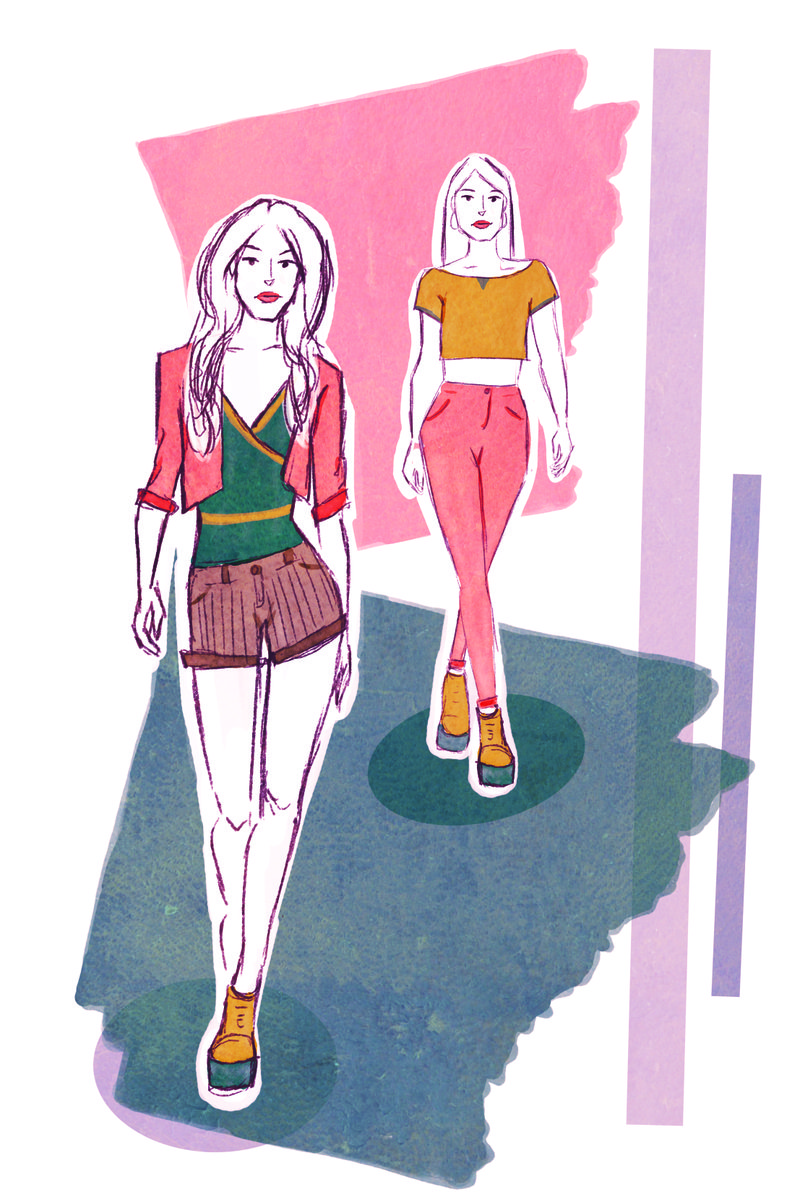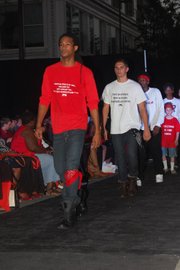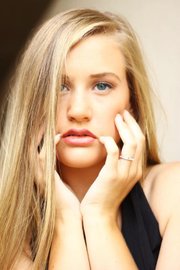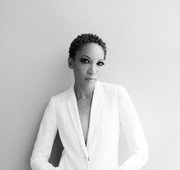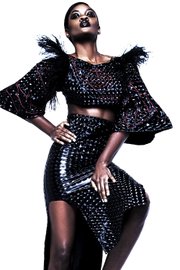It was Linda Evangelista, notable supermodel of the 1990s, who famously said, "I don't get out of bed for less than $10,000 a day."
That's easy to believe when one flips through the pages of a sleek, major fashion magazine or is lucky enough to attend Mercedes-Benz Fashion Week, going on in New York through Thursday. Those tall, aloof, unsmiling human mannequins with legs that go on for days navigate the runway with shoulders back, switching nonchalantly to house music and looking like they lead glamorous lives.
With Little Rock's fashion-show presence having grown, New York-style productions can be seen right here in the Natural State. And the models who strut the catwalks of Little Rock Fashion Week, Northwest Arkansas Fashion Week, Designers Choice Fashion Preview, and major charity shows like CARTI's Festival of Fashion or Easter Seals' The Fashion Event seem to have it all, just like shows with the Linda Evangelistas and Heidi Klums and Kate Mosses.
Or do they? This is Arkansas, after all. What is life like for a model in the Natural State? What myths exist when it comes to modeling here?
"One of the biggest myths of modeling is that we are 'just models,'" says Treloni Flournoy of Little Rock, who models regularly for Little Rock resident and Project Runway reality-show star Korto Momolu. "I have heard that phrase over the years with sort of a dismissive tone ... mostly when traveling outside of this market, but some here as well."
Not true, maintains Flournoy -- who began gracing catwalks 21 years ago when her parents enrolled her in modeling school and who has displayed fashions here as well as in New York, Florida, Texas, Louisiana, Tennessee and the Cayman Islands.
"We are professionals with careers," she says. "We are wives, mothers, husbands, dads, students, givers, entrepreneurs ... all striving for excellence. Of the models I have been able to know personally, we are a community supporting each other in modeling and other aspects of life."
And, well, there's that myth concerning the money.
A PENNY EARNED
Says Larry Scruggs of Pine Bluff, who has modeled for Dillard's and whose appearances include Little Rock Fashion Week every year: "They always think that you're making the big bucks, first of all -- just because you're saying that you model -- that you're making millions upon millions of dollars, which is not true. There's a few that come in and get signed with a big name or get an exclusive deal."
But in Arkansas, chances are that model will be working somewhere else. Scruggs says he has made money from the profession he took up more than six years ago, but not enough to do modeling exclusively.
The fashion shows and events in Arkansas tend to provide local exposure
more than work opportunities, says S'cie Ward, who operates Major Market Models & Talent in Little Rock. "The local shows are fun and give the models the boost they need to say, 'I want to do this for a living.'"
Rudy Orona, one of her clients, concurs. He, too, currently works a day job that has allowed him to model without being compensated.
"I'm sure many models would say that there are obstacles that they have to face being in the local industry -- [including] many times not getting compensated for their work or involvement," says Orona, who has modeled for four years. "And I would agree with that."
Another myth that dogs models: They're vain. Well, how can they not be, their observers ask. They're good looking, thin, and get to show off all those fabulous clothes.
Scruggs says, "A lot of people also think that we're arrogant and stuck-up, which is so not true. I've met a lot of models that are very, very humble."
Take him, for instance.
"I'm not a big fan of showing off ... my body," Scruggs says. "I'm very self-conscious about how I look and how people perceive me. So I kind of [have] faith in myself when it comes to being a model. But I've learned to humble myself and to know that this is something that I'm doing because I've gotten the opportunity."
STRUTTIN' AIN'T EASY
There's also the myth that modeling is an easy-peasy thing. All a model has to do is walk down the runway in somebody else's clothes, right?
Not so, insist those in the know.
When Morgan Marie Kennedy (her stage name for privacy reasons) started out in the business, she figured it'd be easy, she would get paid and "it was going to be straight-up high fashion." She knows now that it's not really how it is.
"You have to ... use your steppingstones in order to get in, make connections, and find the right people," says Morgan, 13, a high school freshman who models in Little Rock and other cities. "You have to network -- a lot, and spend a lot of hours on what you do" -- hours training, practicing, being fitted, getting hair and makeup done, or even getting to the modeling venue. Morgan's mother, Ann Marie, is a single working mother who sometimes spends all night driving Morgan to out-of-town shows. Once they arrive, Morgan may have to go immediately to prepare for the show ... without getting any sleep.
"You have to be dedicated to make it in this industry," Ann Marie says. "You have to go above and beyond."
Luckily, having competed in and won many pageants, Morgan was used to hard work.
"You have to make a name for yourself before you can demand that other people pay you for what you do in your career," she says. "A lot of people are going to look at you and say, 'I have 15 of you that don't have to be paid.' If you want somebody to know who you are and respect your brand and you want to get paid, you do have to work. A lot."
And just because someone has the look and credentials of a model doesn't mean that getting chosen for gigs is going to be easy.
"Just being African-American in this market" can be a challenge, says Bridgette Jones of Pine Bluff, Little Rock Fashion Week's 2015 Model of the Year.
Many of those seeking models are looking for "fair-skinned" models, says the 19-year-old University of Arkansas at Pine Bluff sophomore. Even among those who seek black models, the natural-textured hair of a black woman isn't as widely accepted. "I'm natural so ... there have been times when they say, 'Oh, your hair is a distraction,' and I'm going to need to find a wig," Jones says.
She has learned to take the hair thing in stride. "That's something I struggled with before but now ... it's a job so you've gotta go with it. ... I am the model, so we're just a mannequin, basically."
SPREADING ONE'S WINGS
One of the toughest tasks for Arkansas models who want to model on the national or international scene: transcending the local market.
"Leaving local to go professional will mean going into development," Ward says. Once a model decides to go professional, she should immediately seek guidance with an agency with a reputable track record -- "a mother agency if you've exhausted the local market and need help," Ward adds. (A mother agent or agency is defined at modelscouts.com as "usually the first modeling agency you begin working with when you start your modeling career.")
Darria Johnson, formerly of Little Rock, has modeled since the age of 12. She signed with Major Market Models after finishing college in 2014 and is now signed with Presence Models in Atlanta. "Spending too many years in the local market will not prepare a model for the professional world," Johnson says. "Local markets aren't metropolitan areas, which means that they don't receive the [attention] that markets like New York, Atlanta or Dallas receive."
And what may be acceptable standards for models in a smaller market aren't necessarily acceptable in a bigger market, says Yancey Prosser, director for The Agency in Little Rock.
"It's difficult to find that girl or that guy in Arkansas that's the right height, the right size, who has the right look, who photographs well, who has the opportunity and the availability to do it," Prosser says. "I'm a very positive person in my personal life, but then when it comes to this industry I'm honest. And I'm going to tell a 5-foot-2 girl she's not going to do runway. I'm not going to lead someone on. She may be gorgeous, but she's still not going to be a runway model." He adds that being 5 feet 10 inches tall and having "the right build -- no hips, long legs, and a lot of that's hereditary" -- is what the fashion industry wants.
"The best thing for someone to do is to go to a department store, get a size 2 dress, hold the hanger up and that's what they want it looking like on a model. The model is the hanger." Even plus-size models can't be all that plus-size. Most who come to The Agency wanting to be plus-size models are size 18-20, Prosser says. "But size 14 girls are the ones sought.
"It's a crazy business. It's all about size, how you photograph, how you move."
Meanwhile, although the local models may have aspirations of moving on to bigger runways, they would also like to see the Arkansas market get noticed. "[There's] a lot of gifted people in Arkansas," Jones says.
Scruggs agrees.
"We are doing the same thing that everybody else is doing," he says. "We have so much potential, and it's so great here, [but] it's being overlooked. And people should start just paying attention to what's going on here.
"Soon as the right people, or the right person, sees everything that's just here, it's going to take off. There's no way that it can't. You can only hide the sun for so long."
Style on 09/15/2015
